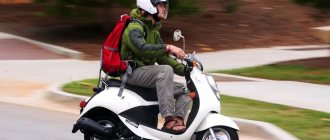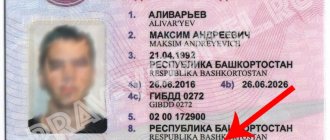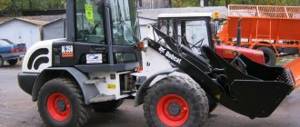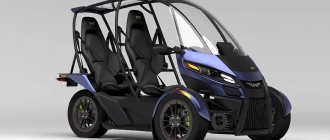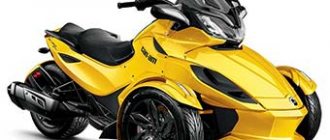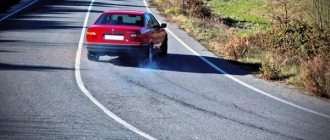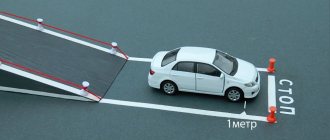Categories of rights to a forklift
Anyone wishing to legally operate loading equipment should decide on several issues:
- How and where are forklift licenses issued?
- What category of rights and rank are required to work on a vehicle?
Having dealt with organizational issues, decide on the choice of a specialized driving school, submit the documents and start classes so that in 2 - 3 months you will receive a category for driving a forklift.
Further, in the article: categories of rights and categories, a list of required documents, the procedure for registering and obtaining a new driver’s license.
The need to strictly classify existing auto-loading equipment is caused by the variety of types and functional features of vehicles.
Category types:
- A (I - IV) - control of certain types of “off-road vehicles” - ATVs, snowmobiles, warehouse loaders with a power of up to 4 kW;
- B - for wheeled and tracked vehicles with power: 4 - 25.7 kW;
- C— for wheeled vehicles 25.7 – 110.3 kW;
- D - for wheeled vehicles from 110.3 kW;
- E— for tracked loaders from 25.7 kW;
- F—for agricultural machinery.
Everyone who completes courses in the chosen specialty is issued a tractor driver's certificate marked: category-rank.
What licenses are required for forklifts and front-end loaders?
There are many types of forklifts, for example:
Forklift (“car”) – a forklift with forks and a counterweight; Front-end – a type of bucket loader; Bobcat – mini skid steer loader; Stacker and reach truck are vehicles for lifting and stacking cargo in several tiers. To operate a loader, you need a Tractor Driver's Certificate issued by Gostekhnadzor.
Rank
ETKS (Unified Tariff and Qualification Directory) is a document regulating the assignment of categories. The purpose of the document is to determine the level of planned work and assign categories based on the complexity of vehicle management and maintenance. The directory is also used when drawing up programs for training and retraining of personnel.
Classification of categories:
- 2 tracked and wagon loaders, devices for grabbing cargo during storage, transportation, loading (unloading), under the supervision of a qualified specialist.
- 3 - battery-powered vehicles and lifting mechanisms for loading and unloading operations of all types.
- 4 - 7 - tractors, wagon loaders, and other auto-loading mechanisms. The calculation and distribution of 4-7 digits is carried out in accordance with the power of the vehicle, from less to more powerful.
7th category - means the maximum level of qualification and the highest complexity of the vehicle. As a rule, these are powerful front loaders from 200 kW for serious loading and unloading work of large volumes.
ETKS forklift driver
Section “Professions of workers common to all sectors of the national economy”
Forklift driver 2nd category
Characteristics of the work .
1. Control of tractor loaders and unloaders, car loaders, car unloaders and all special load-handling mechanisms and devices when loading, unloading, moving and stacking various cargoes under the guidance of a more highly qualified driver. 2. Participation in scheduled preventive maintenance of loading and unloading and load-handling mechanisms and devices.
Must know:
— basic information about the design of serviced loaders and loading and unloading mechanisms and their units; — instructions for their operation, installation, start-up, regulation and running-in; — characteristics of oils and lubricants; — causes of malfunctions and methods for eliminating them.
Forklift driver 3rd category
Characteristics of work.
1. Control of battery-powered forklifts and all special lifting mechanisms and devices when loading, unloading, moving and stacking cargo. 2. Maintenance and current repair of the loader and all its mechanisms. 3. Determination of malfunctions in the operation of the loader, its mechanisms and their elimination. 4. Installation and replacement of removable load-handling devices and mechanisms. 5. Participation in carrying out scheduled preventive maintenance of the loader and load-handling mechanisms and devices. 6. Charge the batteries.
Must know:
— battery loader device; — methods of loading and unloading cargo on all types of transport; — rules for lifting, moving and stowing cargo; — rules of street traffic, traffic on the territory of the enterprise, station tracks and installed alarm systems; — basic information on electrical engineering.
Forklift driver 4 - 7 ranks
Characteristics of work.
1. Control of tractor loaders, car loaders, car unloaders and all special load-handling mechanisms and devices when loading, unloading, moving and placing cargo in stacks and dumps. 2. Maintenance of the loader and current repairs of all its mechanisms. 3. Determination of malfunctions in the operation of the loader. 4. Installation and replacement of removable load-handling devices and mechanisms. 5. Participation in carrying out scheduled preventive maintenance of the loader, load-handling mechanisms and devices.
Must know:
— arrangement of forklifts and batteries; — methods of loading and unloading cargo on all types of transport; — rules for lifting, moving and stowing cargo; — rules of the road, traffic on the territory of the enterprise and station tracks; — types of fuels and lubricants used; — names of basic materials for battery production; — rules for handling acids and alkalis.
Tariffication 4-7 categories:
4th category - when working on a tractor loader with a power of up to 73.5 kW (up to 100 hp); 5th category - when working on a tractor loader with a power of over 73.5 kW (over 100 hp) and when working on a loader with a power of up to 147 kW (up to 200 hp) using it as a bulldozer, scraper, excavator and other machines; 6th category - when working on a loader with a power of over 147 kW (over 200 hp) to 200 kW (up to 250 hp) using it as a bulldozer, scraper, excavator and other machines; 7th category - when operating a loader with a power of over 200 kW (over 250 hp), equipped with a complex electronic control system, a telescopic or frontal boom and intended for loading and unloading large-capacity containers.
Documents for front loader
Issuing rights to operate special equipment is the responsibility of Gostekhnadzor, the state organization that controls the use of self-propelled vehicles.
What category of license is needed for a front-end loader, and what is this vehicle?
A front loader is a self-propelled mechanism for lifting, grabbing and moving cargo, in particular bulk materials - it is at the same time an excavator, leveler, bulldozer, etc.
Classes and passing exams for permission to work on a front loader involve mastering the theoretical part and gaining practical skills when tested at training grounds.
ABOUT
Features of classes for working on a forklift:
- Course duration: 1.5 months.
- Mandatory exam after graduation.
- Issuance of a temporary certificate.
After completing the course completion document, the future driver will have to pass a duplicate exam at Gostekhnadzor and receive a full license with an open category.
Training to become a “Forklift Driver” with issuance of a certificate in Moscow
The driver of a forklift, in addition to a category C or D driver's license, must have the appropriate certificate. Without such a “crust”, a specialist will not be allowed to operate special equipment.
It is possible to obtain the necessary document without interrupting work - to do this, complete distance learning to become a forklift driver in our training center. As a result of completing the course, you will be able to receive a “test” that confirms your professional competencies and is a permit to work.
Please note that you can buy a forklift driver's license and complete the training program at a time convenient for you.
The process of obtaining a certificate is quite simple and will take a minimum of time. You will need to do the following:
- Fill out an application for distance learning courses.
- Provide the necessary documents (scan of forklift driver training diploma, scan of work record book, tractor driver’s license, organization details for invoicing).
As a result of completing the course, you will receive a new type of forklift driver's license. It will contain the seal of the educational institution and information about the timing of the courses and the assigned qualifications. However, the “crust” does not include permission to work on a certain type of equipment.
Diesel forklift
Diesel forklifts are vehicles for warehouses with an internal combustion engine. Diesel forklifts are designed for transporting goods inside warehouses.
The duration of training at a certified training center for diesel forklift drivers is 3 months. The training process is identical to the training course for front-end loaders - this is a theoretical part on knowledge of traffic rules and practical driving, on a race track, under the guidance of instructors, then passing tests to a representative of Gostekhnadzor and obtaining a license.
The license to drive a diesel forklift is valid for 10 years, after which the driver must undergo retraining, pass an exam and receive a new license.
A mandatory rule for drivers of diesel forklifts is annual recertification to ensure the required level of qualifications.
Electric forklift
An electric forklift is a type of warehouse equipment with functionality similar to a diesel forklift.
Advantages of an electric forklift:
- ergonomics in maintenance and repair;
- quiet operation;
- environmental safety, the ability to use transport to work in “clean” rooms.
Electric warehouse forklifts run on AC batteries.
Licenses to operate electric forklifts are issued at certified driving schools. Course duration is 2 months. The course consists of theoretical and practical parts. Next, students take tests, receive temporary licenses and undergo an internship. He completes his studies with an exam at Gostekhnadzor. If successful, the electric forklift driver receives a permanent license (category BC) for a period of 10 years.
Features of the training course
Legal operation of loading and unloading equipment requires that the driver of the vehicle has an appropriate license indicating the category of approval. The category includes certain types of forklifts, differing in design and functional features.
Before starting training, the driver determines which vehicle he plans to work on and selects the appropriate course, after which it becomes possible to calculate the cost and duration of training.
General characteristics of the categories of rights to a forklift:
- Category B - low-power vehicles, weight up to 5 tons (mini-equipment).
- Category C - loaders with power: 25-110 kW.
- Category D - forklifts over 110 kW.
Training lasts from 1.5 to 3 months, depending on the complexity of the chosen category.
The legislation of the Russian Federation indicates a mandatory requirement for forklift drivers: to obtain a license, you must complete a training course at a certified center and pass an exam at Gostekhnadzor. Passing the theory is mandatory for drivers with a “clean” license, without open categories.
Everyone takes the practical driving test, regardless of whether or not they have a license. After passing the practical part of operating a forklift, examinees receive forms with the exam result.
The State Traffic Inspectorate does not issue licenses for special equipment, including forklifts. Issuing driver's licenses of this type is the direct responsibility of Gostekhnadzor.
What do real “rights to retribution” look like?
After completing the training, a “Certificate of Profession” is issued.
A person who has completed the training is allowed to take the exam. After successful completion, a license to operate a loader is issued (correctly they are called “Tractor Driver’s Certificates”). Here is a sample license for a forklift:
Documents and registration
When enrolling in a forklift driver course, make sure that the selected center has a state license and a package of documents that allows you to conduct classes and issue temporary certificates for driving a vehicle.
After receiving a certificate of completion of the special course, the future driver is obliged to contact the local branch of Gostekhnadzor and provide documents for exchanging temporary licenses for permanent ones:
- Russian passport;
- temporary certificate;
- receipt of payment of the duty;
- photographs (3x4);
- health certificate;
- a copy of the exam form.
Having completed the documents at Gostekhnadzor and passed the final test, the driver will have to wait 7-10 days until a new type of certificate is issued for the forklift driver, after which he can legally begin work.
